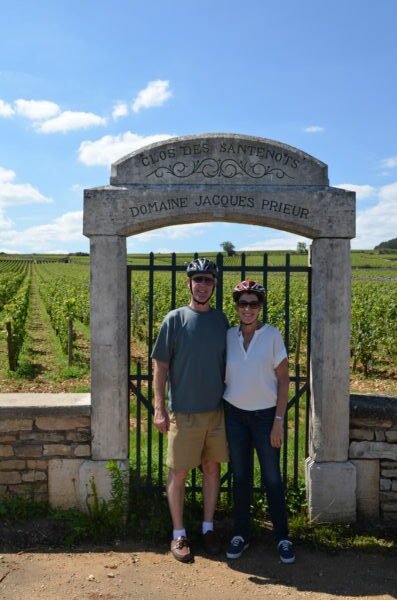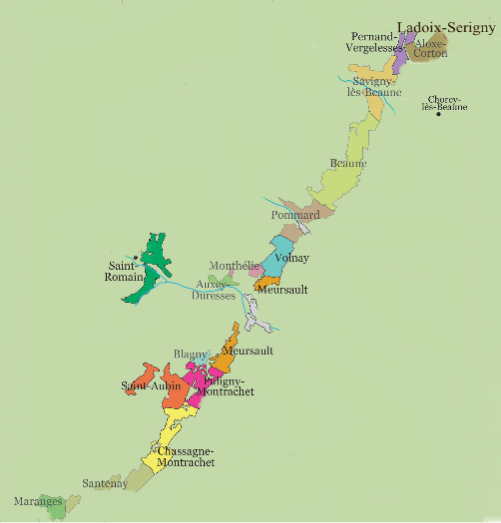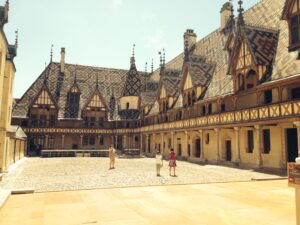
Welcome to Part II of Sorting Out Burgundy. Today we explore the Côte de Beaune, which is the southern half of Burgundy's famed Côte d'Or. The picture above shows the Wine Concepts team during a bicycle tour of the Côte de Beaune vineyards. If you're wondering if bicycles and wine are a good idea . . . despite numerous wine tastings along the way, no bicyclists were injured or unaccounted for at the end of the day. As best I can recall.
Before we get started, if you want a quick review of Burgundy, check out the Wine Concepts Burgundy primer.
And, to get in the mood, why not tune in to a Beaune music radio station? Just click on the following link, and when it opens click on “Le direct” (French for “live”). When it loads, pop a cork on our Wine of the Week (a Santenay Pinot Noir discussed below), sit back and enjoy! https://www.francebleu.fr/bourgogne
The Côte de Beaune.
The Côte de Beaune begins at Ladoix-Serigny, just south of the Côte de Nuits, and extends approximately 12 miles to Maranges. The principal appellations are shown on the map below. The region surrounds the city of Beaune, which is considered the "wine capital of Burgundy" because of the concentration of wine businesses located there. It produces about 55 percent red and 45 percent white wine. Although finding a good, reasonably priced wine from the Côte de Beaune can be challenging, there are good values to be found in the lesser known villages and the Côte de Beaune - Villages regional appellation.

A quick word on the city of Beaune. It's a great place to visit. The Hospice de Beaune (shown below), founded in 1443 to provide medical care for the poor, is amazing. The Hospice is funded by the auction of wine made from 150 acres of vineyards that were donated over the years. Other "don't miss" attractions are the Marché aux Vin, which sells and ships a wide selection of wines, and Bouchard Père et fils, where you can tour extensive cellars, located in a 15th century fort, and taste a variety of their wines.

The Côte de Beaune is best known for high-quality white wines produced from Chardonnay. About 45 percent of the wine produced in the region is white, but this includes some of the finest Chardonnay in the world. The white wines are powerful, intensely flavored, and typically have notes of apple, pear and hazelnut. These are a great match for white meat and fish, as well as lobster.
White wine production is generally concentrated from Meursault southward. There are, however, some Grand Cru and Premier Cru white vineyards just north of Beaune.
- Meursault produces almost as much white wine as the rest of the Côte de Beaune village appellations combined, so you shouldn't have any problems finding it. The better wines have a richness and nutty notes.
- Value whites. For a good quality, value white wine look to Saint-Aubin. These are crisp, light-to-medium bodied wines, with aromas of white flowers, apple and almond. A Wine Concepts favorite producer is Hubert Lamy.
- The Grand Cru. Let's say you just hit the lottery. The best of the Côte de Beaune white wines come from the eight Grand Cru, and the best of the best is Le Montrachet. Alexander Dumas, the author of the Three Musketeers, once said that "Montrachet should be drunk kneeling with one's hat off." Perhaps he was trying to justify why he was kneeling on the floor after a Montrachet binge.
The red wine appellations are concentrated around the city of Beaune. The red wines, made from Pinot Noir, generally have slightly less body and tannin than those from the Côte de Nuits, and feature notes of red fruits and earthiness.
- The best red wines in the Côte de Beaune are produced in Pommard and Volnay. These two villages produce exclusively red wines that are quite different in character. Pommard wines are powerful, with intense flavors and aromas. Volnay wines are more delicate and fragrant, but less powerful than Pommard.
- Beaune produces mostly red wine that is not quite as good as Pommard and Volnay. While generally good quality, these wines can vary significantly in body and intensity. They tend to have firm tannins, but are less powerful than Pommard.
- The Côte de Beaune - Villages appellation produces only red wine. It can be produced from grapes grown in any of fifteen communes across the region, and tends to be relatively inexpensive. These are soft, fruity, less flavorful wines.
Wine of the Week. Finding a reasonably priced Côte de Beaune village-level appellation wine can be a challenge. We selected a 2015 Louis Jadot Santenay Clos de Malte ($35 retail). The wine comes from Santenay, the southernmost significant village in the Cote de Beaune. Although not particularly well known among American wine consumers, Santenay produces the fourth largest volume of wine of the village appellations in the Cote d’Or, so its wines should be easy to find. Clos de Malte is the name of the vineyard (in Burgundy, "clos" means a vineyard surrounded by a stone wall). This wine is made from 100 percent Pinot Noir grapes, and is aged for one year in oak barrels. This is a very nice wine, a good representation of what a village-level Côte de Beaune Pinot should be. On the nose there is red fruit, primarily cherry with hints of strawberry, and there is a distinct earthiness. The tannins are evident but pleasant. Medium bodied. Overall, a balanced and pleasant wine that’s worth the money but not by any means a value wine. It pairs well with lean, rare beef, grilled tuna, poultry and veal.
